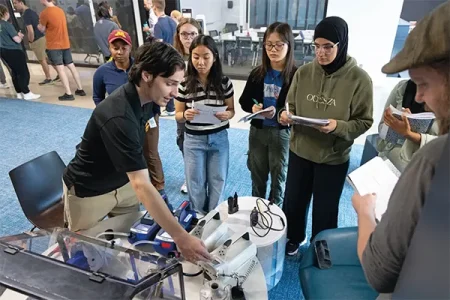A new School of Public Health (SPH) research center is part of the largest investment ever made by the U.S. government to scale up infectious disease outbreak modeling and forecasting. The Midwest Analytics and Disease Modeling Center (MADMC) is a partnership between the SPH and University of Minnesota Medical School, the Minnesota Department of Health (MDH), and the Minnesota Electronic Health Records Consortium.
MADMC becomes one of 13 connected organizations across the U.S. that form a national outbreak response network collectively known as Insight Net, created by the Centers for Disease Control and Prevention (CDC) Center for Forecasting and Outbreak Analytics.
The Center for Forecasting and Outbreak Analytics formed in 2022 in response to the COVID-19 pandemic with the aim of creating “the equivalent of the National Weather Service for infectious diseases.”
For its part, MADMC will strengthen the public health workforce by supporting training in disease modeling and analytics, as well as by the creation of tools to allow decision makers to weigh potential outcomes and respond to emerging infectious diseases.
The problem during COVID and other outbreaks, explains Eva Enns, associate professor at the SPH, is that you can’t accurately predict the impact of policies like mask mandates and school closures without having a baseline understanding of people’s daily interactions.
“With disease models, if you’re going to try and extrapolate how a disease spreads in different populations, you need to understand how your population interacts with each other and what that means for transmission. And that’s not information we have in the United States,” says Enns.
To address that gap, the center has created the MN Social Contact Survey, which will measure how many people a person interacts with in a day — a key component to modeling the spread of an infectious disease. The survey will also take into account seasonal changes in contact patterns and differences in those patterns by age, gender, race and ethnicity, and rural versus urban locations.
“Trying to gather similar data in the middle of the pandemic was a nearly insurmountable challenge,” says Enns.
Survey data will support the creation of a range of tools adaptable to a variety of infectious diseases that will provide reliable information to policymakers about the severity, transmission potential, and likely health impact of emerging public health threats, as well as effects of different policy choices on Minnesota communities.
“An additional challenge of the COVID pandemic — and any infectious disease outbreak — is to first recognize a new threat,” says Adams Dudley, a project co-lead and professor in the University of Minnesota Medical School.
When health care workers were told to watch for cough, fever, and shortness of breath — symptoms of COVID which are shared by the common cold and flu — they may have missed symptoms unique to COVID, like loss of taste and smell. Additionally, infections were only counted if people came to an emergency room and/or were hospitalized.
But because of the creation of the Minnesota Electronic Health Records Consortium in 2020, which brings together the largest health systems in Minnesota, the health records of 90% of Minnesotans are now computerized and therefore more easily analyzed by software looking for symptom associations and patterns. MADMC will create programs that scan health records quickly to pull out case counts and unique disease symptoms.
MDH, in turn, will apply those insights to the public health response. And that’s key, explains Enns.
“[The CDC] doesn’t just want this to be a network of academics doing academic things at universities. They want these things to be translated into practice and into operations within public health agencies, which is why we have a strong partner in the leadership of the center,” says Enns of her third project co-lead, Kristin Sweet of MDH.
Enns notes the center will also provide opportunities for students through a summer fellowship program where students will work directly with MDH employees.
“One of the goals for the network is to get people with analytical backgrounds and skills actually moving into public health jobs within public health agencies,” says Enns. “That’s exciting for our students, because they don’t usually get to work on projects that are so well integrated with the end user.”
Dudley says the center and the larger Insight Net could fundamentally change how the public and policymakers work together to minimize public health threats. “If we have better information, we can use that information so that policymakers, instead of saying ‘We’re going to have a mask mandate,’ can say to the public, ‘Right now the number of cases is ‘x.’ If we put in a mask mandate, we expect the number of cases in a month will be x,’” says Dudley.
“And then we can have a good public discussion about whether or not that’s a good decision.”



